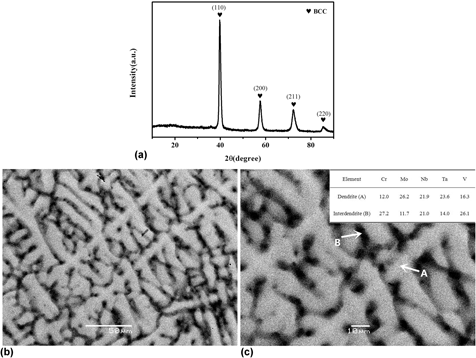Crossref Citations
This article has been cited by the following publications. This list is generated based on data provided by
Crossref.
Sheikh, S.
Gan, L.
Ikeda, A.
Murakami, H.
and
Guo, S.
2020.
Alloying effect on the oxidation behavior of a ductile Al0.5Cr0.25Nb0.5Ta0.5Ti1.5 refractory high-entropy alloy.
Materials Today Advances,
Vol. 7,
Issue. ,
p.
100104.
Li, Jian-Hong
and
Tsai, Ming-Hung
2020.
Theories for predicting simple solid solution high-entropy alloys: Classification, accuracy, and important factors impacting accuracy.
Scripta Materialia,
Vol. 188,
Issue. ,
p.
80.
Zhu, Man
Yao, Lijuan
Liu, Yongqin
Zhang, Mao
Li, Kun
and
Jian, Zengyun
2020.
Microstructure evolution and mechanical properties of a novel CrNbTiZrAlx (0.25 ≤ x ≤ 1.25) eutectic refractory high-entropy alloy.
Materials Letters,
Vol. 272,
Issue. ,
p.
127869.
Veselkov, Sergey
Samoilova, Olga
Shaburova, Nataliya
and
Trofimov, Evgeny
2021.
High-Temperature Oxidation of High-Entropic Alloys: A Review.
Materials,
Vol. 14,
Issue. 10,
p.
2595.
Gorr, Bronislava
Schellert, Steven
Müller, Franz
Christ, Hans-Jürgen
Kauffmann, Alexander
and
Heilmaier, Martin
2021.
Current Status of Research on the Oxidation Behavior of Refractory High Entropy Alloys.
Advanced Engineering Materials,
Vol. 23,
Issue. 5,
Gabrysiak, Katharina Nicole
Gaitzsch, Uwe
Weißgärber, Thomas
and
Kieback, Bernd
2021.
Oxidation and Hot Gas Corrosion of Al–Cr–Fe–Ni‐Based High‐Entropy Alloys with Addition of Co and Mo.
Advanced Engineering Materials,
Vol. 23,
Issue. 9,
Romero, Rebecca
Makeswaran, Nanthakishore
Naraparaju, Ravisankar
and
Ramana, Chintalapalle V.
2021.
Examination of the Oxidation and Metal–Oxide Layer Interface of a Cr–Nb–Ta–V–W High Entropy Alloy at Elevated Temperatures.
Advanced Engineering Materials,
Vol. 23,
Issue. 8,
Ke, Lingsheng
lin, chun
Tan, Mingtian
and
Meng, Long
2022.
High-Temperature Oxidation Behaviors of Rare Earth La and Y Doped Alcrtisi0.2 High-Entropy Alloy.
SSRN Electronic Journal ,
Fang, Qihong
Lu, Weizheng
Chen, Yang
Feng, Hui
Liaw, Peter K
and
Li, Jia
2022.
Hierarchical multiscale crystal plasticity framework for plasticity and strain hardening of multi-principal element alloys.
Journal of the Mechanics and Physics of Solids,
Vol. 169,
Issue. ,
p.
105067.
Yan, Yonggang
McGarrity, Kade A.
Delia, Daniel J.
Fekety, Curtis
and
Wang, Kun
2022.
The oxidation-resistance mechanism of WTaNbTiAl refractory high entropy alloy.
Corrosion Science,
Vol. 204,
Issue. ,
p.
110377.
Romero, Rebecca A.
Xu, Shuozhi
Jian, Wu-Rong
Beyerlein, Irene J.
and
Ramana, C.V.
2022.
Atomistic simulations of the local slip resistances in four refractory multi-principal element alloys.
International Journal of Plasticity,
Vol. 149,
Issue. ,
p.
103157.
Schellert, S.
Weber, M.
Christ, H.J.
Wiktor, C.
Butz, B.
Galetz, M.C.
Laube, S.
Kauffmann, A.
Heilmaier, M.
and
Gorr, B.
2023.
Formation of rutile (Cr,Ta,Ti)O2 oxides during oxidation of refractory high entropy alloys in Ta-Mo-Cr-Ti-Al system.
Corrosion Science,
Vol. 211,
Issue. ,
p.
110885.
Cheng, Wei
Ji, Lingfei
Zhang, Litian
Wang, Hao
and
Sun, Weigao
2023.
Refractory high-entropy alloys fabricated using laser technologies: a concrete review.
Journal of Materials Research and Technology,
Vol. 24,
Issue. ,
p.
7497.
Romero, Rebecca
Beyerlein, Irene J.
and
Ramana, C. V.
2023.
Microstructure and Oxidation Behavior of a CrMoNbTaW Refractory High Entropy Alloy.
ACS Applied Engineering Materials,
Vol. 1,
Issue. 1,
p.
132.
Ke, Lingsheng
Meng, Long
Fang, Sheng
Lin, Chun
Tan, Mingtian
and
Qi, Tao
2023.
High-Temperature Oxidation Behaviors of AlCrTiSi0.2 High-Entropy Alloy Doped with Rare Earth La and Y.
Crystals,
Vol. 13,
Issue. 8,
p.
1169.
Odabaş, Ömür Can
İnceyer, Ahmet Arda
Usta, Metin
Zeytin, Havva Kazdal
and
Yücel, Onuralp
2024.
The improvement in high-temperature oxidation resistance of Ni0.25Co0.25Cr0.22Mo0.14Re0.14 high entropy alloy via industrial chemical vapor aluminizing process.
Materials Chemistry and Physics,
Vol. 325,
Issue. ,
p.
129769.
Tong, Zhaopeng
Zhang, Yuze
Liu, Huaile
Wan, Wenbin
Zhou, Wangfan
Ye, YunXia
and
Ren, Xudong
2024.
Laser shock peening of AlCoCrCuFeNi high-entropy alloy fabricated by laser powder bed fusion: An enhanced oxidation-resistance mechanism at high-temperature.
Corrosion Science,
Vol. 226,
Issue. ,
p.
111667.
Bamisaye, Olufemi Sylvester
Maledi, Nthabiseng
Van der Merwe, Josias
and
Bodunrin, Michael Oluwatosin
2024.
Microstructure, hardness, oxidation, and corrosion behavior of TiNbTaVW refractory high entropy alloy in 3.5 wt% NaCl and 1 M H2SO4.
Journal of Alloys and Compounds,
Vol. 983,
Issue. ,
p.
173803.
Bamisaye, Olufemi Sylvester
Maledi, Nthabiseng
Van der Merwe, Josias
and
Bodunrin, Michael Oluwatosin
2024.
Microstructure, hardness, oxidation and corrosion behavior of Cr(VNb)2 Laves containing CrNbTaVW RHEA in 3.5 wt% NaCl and 1 M H2SO4.
International Journal of Refractory Metals and Hard Materials,
Vol. 121,
Issue. ,
p.
106661.
Li, Yulin
Kurpaska, Łukasz
Lu, Eryang
Xie, Zonghan
Kim, Hyoung Seop
and
Huo, Wenyi
2024.
Body-centered cubic phase stability in cobalt-free refractory high-entropy alloys.
Results in Physics,
Vol. 60,
Issue. ,
p.
107688.
